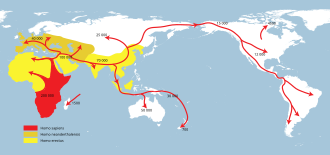Paleolithic
Lower Paleolithic

The first known hominids evolved in Africa. According to paleontology, the early hominids' skull anatomy was similar to that of the gorilla and the chimpanzee, great apes that also evolved in Africa, but the hominids had adopted a bipedal locomotion which freed their hands. This gave them a crucial advantage, enabling them to live in both forested areas and on the open savanna at a time when Africa was drying up and the savanna was encroaching on forested areas.
By 4 million years ago, several australopithecine hominid species had developed throughout Southern, Eastern and Central Africa. They were tool users, and makers of tools. They scavenged for meat and were omnivores. [1]
By approximately 3.3 million years ago, primitive stone tools were first used to scavenge kills made by other predators and to harvest carrion and marrow from their bones. In hunting, Homo habilis was probably not capable of competing with large predators and was still more prey than hunter. H. habilis probably did steal eggs from nests and may have been able to catch small game and weakened larger prey (cubs and older animals). The tools were classed as Oldowan. [2]
Around 1.8 million years ago, Homo ergaster first appeared in the fossil record in Africa. From Homo ergaster, Homo erectus evolved 1.5 million years ago. Some of the earlier representatives of this species were still fairly small-brained and used primitive stone tools, much like H. habilis. The brain later grew in size, and H. erectus eventually developed a more complex stone tool technology called the Acheulean. Possibly the first hunters, H. erectus mastered the art of making fire and was the first hominid to leave Africa, colonizing most of Afro-Eurasia and perhaps later giving rise to Homo floresiensis . Although some recent writers have suggested that Homo georgicus was the first and primary hominid ever to live outside Africa, many scientists consider H. georgicus to be an early and primitive member of the H. erectus species. [3]
Middle Paleolithic

The fossil record shows Homo sapiens (also known as "modern humans" or "anatomically modern humans") living in Africa by about 350,000-260,000 years ago. The earliest known Homo sapiens fossils include the Jebel Irhoud remains from Morocco (c. 315,000 years ago), [4] the Florisbad Skull from South Africa (c. 259,000 years ago), and the Omo remains from Ethiopia (c. 233,000 years ago). [5] [6] [7] [8] [9] Scientists have suggested that Homo sapiens may have arisen between 350,000 and 260,000 years ago through a merging of populations in East Africa and South Africa. [10] [11]
Evidence of a variety of behaviors indicative of Behavioral modernity date to the African Middle Stone Age, associated with early Homo sapiens and their emergence. Abstract imagery, widened subsistence strategies, and other "modern" behaviors have been discovered from that period in Africa, especially South, North, and East Africa. The Blombos Cave site in South Africa, for example, is famous for rectangular slabs of ochre engraved with geometric designs. Using multiple dating techniques, the site was confirmed to be around 77,000 and 100–75,000 years old. [12] [13] Ostrich egg shell containers engraved with geometric designs dating to 60,000 years ago were found at Diepkloof, South Africa. [14] Beads and other personal ornamentation have been found from Morocco which might be as much as 130,000 years old; as well, the Cave of Hearths in South Africa has yielded a number of beads dating from significantly prior to 50,000 years ago, [15] and shell beads dating to about 75,000 years ago have been found at Blombos Cave, South Africa. [16] [17] [18]
Specialized projectile weapons as well have been found at various sites in Middle Stone Age Africa, including bone and stone arrowheads at South African sites such as Sibudu Cave (along with an early bone needle also found at Sibudu) dating approximately 60,000-70,000 years ago, [19] [20] [21] [22] [23] and bone harpoons at the Central African site of Katanda dating to about 90,000 years ago. [24] Evidence also exists for the systematic heat treating of silcrete stone to increase its flake-ability for the purpose of toolmaking, beginning approximately 164,000 years ago at the South African site of Pinnacle Point and becoming common there for the creation of microlithic tools at about 72,000 years ago. [25] [26] Early stone-tipped projectile weapons (a characteristic tool of Homo sapiens), the stone tips of javelins or throwing spears, were discovered in 2013 at the Ethiopian site of Gademotta, and date to around 279,000 years ago. [27]

In 2008, an ochre processing workshop likely for the production of paints was uncovered dating to ca. 100,000 years ago at Blombos Cave, South Africa. Analysis shows that a liquefied pigment-rich mixture was produced and stored in the two abalone shells, and that ochre, bone, charcoal, grindstones and hammer-stones also formed a composite part of the toolkits. Evidence for the complexity of the task includes procuring and combining raw materials from various sources (implying they had a mental template of the process they would follow), possibly using pyrotechnology to facilitate fat extraction from bone, using a probable recipe to produce the compound, and the use of shell containers for mixing and storage for later use. [28] [29] [30] Modern behaviors, such as the making of shell beads, bone tools and arrows, and the use of ochre pigment, are evident at a Kenyan site by 78,000-67,000 years ago. [31]
Expanding subsistence strategies beyond big-game hunting and the consequential diversity in tool types has been noted as signs of behavioral modernity. A number of South African sites have shown an early reliance on aquatic resources from fish to shellfish. Pinnacle Point, in particular, shows exploitation of marine resources as early as 120,000 years ago, perhaps in response to more arid conditions inland. [32] Establishing a reliance on predictable shellfish deposits, for example, could reduce mobility and facilitate complex social systems and symbolic behavior. Blombos Cave and Site 440 in Sudan both show evidence of fishing as well. Taphonomic change in fish skeletons from Blombos Cave have been interpreted as capture of live fish, clearly an intentional human behavior. [15] Humans in North Africa (Nazlet Sabaha, [33] Egypt) are known to have dabbled in chert mining, as early as ≈100,000 years ago, for the construction of stone tools. [34] [35]

Evidence was found in 2018, dating to about 320,000 years ago, at the Kenyan site of Olorgesailie, of the early emergence of modern behaviors including: long-distance trade networks (involving goods such as obsidian), the use of pigments, and the possible making of projectile points. It is observed by the authors of three 2018 studies on the site, that the evidence of these behaviors is approximately contemporary to the earliest known Homo sapiens fossil remains from Africa (such as at Jebel Irhoud and Florisbad), and they suggest that complex and modern behaviors began in Africa around the time of the emergence of Homo sapiens. [36] [37] [38] In 2019, further evidence of early complex projectile weapons in Africa was found at Adouma, Ethiopia dated 80,000-100,000 years ago, in the form of points considered likely to belong to darts delivered by spear throwers. [39]
Upper Paleolithic
Around 65–50,000 years ago, the species' expansion out of Africa launched the colonization of the planet by modern human beings. [40] [41] [42] [43] By 10,000 BC, Homo sapiens had spread to most corners of Afro-Eurasia. Their dispersals are traced by linguistic, cultural and genetic evidence. [2] [44] [45] Eurasian back-migrations, specifically West-Eurasian backflow, started in the early Holocene or already earlier in the Paleolithic period, sometimes between 30-15,000 years ago, followed by pre-Neolithic and Neolithic migration waves from the Middle East, mostly affecting Northern Africa, the Horn of Africa, and wider regions of the Sahel zone and East Africa. [46]

Affad 23 is an archaeological site located in the Affad region of southern Dongola Reach in northern Sudan, [47] which hosts "the well-preserved remains of prehistoric camps (relics of the oldest open-air hut in the world) and diverse hunting and gathering loci some 50,000 years old". [48] [49] [50]
The earliest physical evidence of astronomical activity may be a lunar calendar found on the Ishango bone dated to between 23,000 and 18,000 BC from in what is now the Democratic Republic of the Congo. [51] However, this interpretation of the object's purpose is disputed. [52]
Scholars have argued that warfare was absent throughout much of humanity's prehistoric past, and that it emerged from more complex political systems as a result of sedentism, agricultural farming, etc. [53] However, the findings at the site of Nataruk in Turkana County, Kenya, where the remains of 27 individuals who died as the result of an intentional attack by another group 10,000 years ago, suggest that inter-human conflict has a much longer history. [54]

